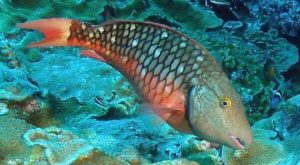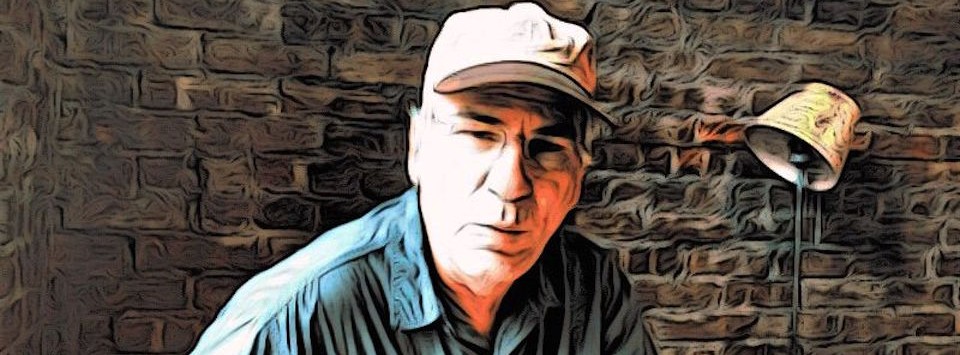Archive: The Great Pacific Garbage Patch
Or: Tainted Tuna Tartare

My good friend Jeff Mann, the true Yard Ramp Guy, has asked me to revisit some of my original posts. This week in my From the Archives series: oh, that flotsam and jetsam...

Trash Flow
There's a floating patch of garbage, larger than Texas, in the middle of the Pacific Ocean.
The Pacific Ocean contains huge, slow moving gyre-shaped currents. Debris that drifts into the calm centers of those gyres tend to stay there. It’s similar in some ways to the nearly self-contained gyre that’s the Sargasso Sea but caused by different things.
The debris that drifts into the biggest one, the North Pacific Subtropical Convergence Zone? Bits of plastic.
When you sail into the Great Pacific Garbage Patch, you won't see a lot of chunks of garbage floating around, and you certainly can't walk on it. Instead, the plastic has broken down into tiny particles that float in the upper layers of the water. Fish frequently mistake it for food and often starve, with stomachs full of plastic.
Many other lifeforms find the plastic poisonous, and as the plastics break down, they leak toxic chemicals into the environment, including ones as nasty as PCBs. (Don't read about PCBs unless you really want to freak yourself out, but if you must, click HERE).
There are even bacteria that have learned to eat the plastics, but they end up producing even nastier toxins much of the time.
As the toxic chemicals and plastics are ingested by fish, jellyfish, and other marine animals, they grow increasingly concentrated, up the food chain, as predators eat toxin-laden critters. Many of those predators in turn, like tuna (which are shockingly high up the food chain) contain much higher levels of toxins than the water around them. And then we, the people in this story, eat them. Bon appétit.
The Great Pacific Garbage Patch isn't alone. There is another major gyre in the Pacific, two in the Atlantic, and one in the Indian Ocean. They all contain garbage patches of their own. What are we doing to clean up these patches? Not much yet, other than research, really. There are lots of plans in the air, but not that much funding.
Yard Ramp Guy Blog: Toward Safer Forklifting
This week, my friend The Yard Ramp Guy helps bring clarity to your inclinations.
Click HERE to ramp up.

Archives: Parrotfish Poop
A Cautionary, er, Tail

My good friend Jeff Mann, the true Yard Ramp Guy, has asked me to revisit some of my original posts. This week in my From the Archives series: that beach only looks beautiful...

The Source of Your Sand Castle
Caribbean beaches are beautiful, even by the standards of tropical beaches, which are pretty high to start with. They're also made largely of poop. Parrotfish poop, to be specific.
(Okay, full disclosure: I’m not currently on a beach. I write this on a Sunday morning, in my robe, from my man cave next to the house here in suburbia. I’m safe. And thanks for caring.)
Move past the thought of that, and it’s a fascinating process:
The brilliantly colored parrotfish possesses a hard beak it employs for eating coral. The fish grinds up the coral in that beak to get at algae and other marine microorganisms growing on it, digests the algae, and then poops out the ground-up coral as a fine sand.
Parrotfish produce a LOT of sand, too. A single green humphead parrotfish can produce more than 200 pounds of sand each year. As much as 85% of the sand on many of these beaches is produced by parrotfish.
Watch it in action HERE, if you dare.
People used to think that parrotfish just ate coral for the polyps and were damaging the reefs. It turns out, though, that most parrotfish species go primarily for dead coral, clearing it for new coral to grow. So, they’re providing a sort of public service.
Parrotfish also eat large amounts of sea sponges, which grow faster than coral and can smother young ones. As it turns out, our parrotfish have a largely symbiotic relationship with the corals they eat. And as we learn more and more about the world, we begin to find more and more of these relationships.
It's not just the Caribbean that owes its beaches to parrotfish. The Maldives, the white sand beaches of Hawaii, and other locations around the world do, as well.
Gorgeous white sand beaches in tropical areas around the world are all made of poop. A little gross, I know. Which is exactly why I'm telling everyone: I’m simply trying to clear out a few of you so that my next beach experience is less crowded.
Yard Ramp Guy Blog: Toward Better Steel
This week, my friend The Yard Ramp Guy is all in on responsible, net-zero steel.
Click HERE to learn why he loves Swedish innovation.

Archives: Landing Instructions
Or: You Traveled a Gazillion Miles to Earth & Left Us Some Stones?

My good friend Jeff Mann, the true Yard Ramp Guy, has asked me to revisit some of my original posts. This week in my From the Archives series: I'm not trying to alienate anyone, but...

Whoa.
I'm convinced that there are aliens out there somewhere, but I'm equally convinced they haven't visited us yet.
There was a book called Chariots of the Gods? written by a hack named Erich von Däniken in 1968 that claimed the aliens visited us in ancient times and were responsible for the construction of the pyramids, Stonehenge, the stone heads of Easter Island and others.
The book was extensively rewritten by its final editor, Wilhelm Utermann, who had been a bestselling Nazi author. The book also claimed that the Old Testament, other ancient religious documents, and countless other folktales and legends were also inspired by visits from aliens in ancient times.
The key to the book's claims of aliens constructing various ancient wonders revolved around the idea that the wonders were far too technologically advanced to have been built by ancient peoples. That's just plain wrong. (I wrote about how the pyramids were built—in my first-ever blog post.)
Every single one of von Däniken's claims of that nature can be rebutted fairly easily. Simply put, our ancestors were incredibly smart and innovative.
Unfortunately, von Däniken's ideas are still floating around in the form of that, ahem, television show “Ancient Aliens,” and it still relies on the ridiculous idea that our ancestors couldn't build anything on their own.
For example, crackpot theorists frequently claim that the Nazca Lines are landing instructions for aliens. I’d say the aliens would’ve developed better methods for setting up landing strips. (Not to mention that the terrain around the Nazca Lines would have made terrible landing strips. Landing on or near the lines would have utterly wrecked the delicate constructions.)
Also, if aliens had visited us in ancient times, do you think they could have given us better gifts than big stone monuments? You know, like plumbing, the germ theory of disease, democracy? Even just some nice farming tips?
Yard Ramp Guy Blog: The Safe Yard Ramp Angle
This week, my friend The Yard Ramp Guy answer a potential customer's concern.
Click HERE to read his response.

Archive: McCoy vs. The Volcano
How a Volcano Invented Science Fiction & the Bicycle

My good friend Jeff Mann, the true Yard Ramp Guy, has asked me to revisit some of my original posts. This week in my From the Archives series: thar she blows...

It Begins...
On April 5th, 1815, Mount Tambora—in present-day Indonesia—began erupting.
The noise made by these eruptions was loud enough to be heard hundreds of miles away. Some English garrisons thought it was cannon fire and sent troops around their islands to investigate.
The eruptions continued until the whole mountain exploded from April 10th and 11th. Mount Tambora's eruption was the single largest in recorded history. So much ash was blasted into the sky that it was pitch black outside as far as four hundred miles away from the mountain.
Tsunamis ravaged the shores of countless islands, and countless more died from ashfall-related complications. (Volcanic ash is really, really nasty stuff, filled with tiny bits of volcanic glass that shred your lungs. Note to file: Don't breathe it in, and don't drink water contaminated with it.)
That was just the start of things, though. By 1816, the Mount Tambora’s airborne ash had spread through the atmosphere to the Northern Hemisphere, kicking off the Year Without a Summer.
A dry fog persisted throughout the spring and summer (what scientists call a “stratospheric sulfate aerosol veil”) that blocked much of the sunlight and kept the temperature from rising to normal levels. Frost began killing off crops in North America, and heavy rain drowned crops in Europe.
Massive famines cased severe social unrest and famine. Hundreds of thousands died in North America, Europe, and Asia. Hungary experienced brown snow, while Italy saw red snow falling throughout the year. The family of Joseph Smith was forced to leave Vermont due to famine, kicking off a chain of events that would lead to the founding of the Mormon Church.
Karl Dranis was inspired by the lack of horses in Germany (no oats to feed them) to invent the velocipede, ancestor of the bicycle.
Mary Shelley, trapped in a Villa with her husband and friends, decided to have a contest to write the scariest story. Her entry, Frankenstein, is commonly considered the original science fiction novel.
I could go on listing consequences for a while. The rapid migration into Indiana and Illinois, leading to their statehoods. Spectacular sunsets. And on and on.
Mount Tambora’s eruption changed the face of the world as we know it. Here's the thing, though: This isn't an anomalous event. It is a singular one, due to its size, but natural disasters and climatic events are major drivers of history, and are far-too seldom treated as such. The current civil war in Syria? One of the primary causes is a drought that led to crop failures.
As much as we like to pretend that we're the bosses of the planet, we need to remember how big our planet is, and how easily it can devastate civilization with a slight shrug.
Yard Ramp Guy Blog: Forklift Ramp Customer Service
This week, my friend The Yard Ramp Guy shows us how repetition makes reputation.
Click HERE to read how he continues to create satisfied customers.






